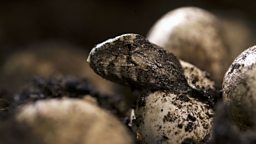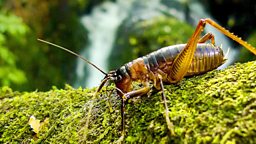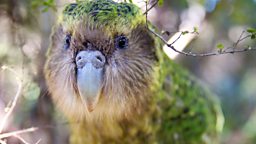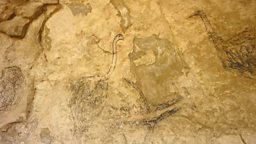Crazy castaways and their tricks
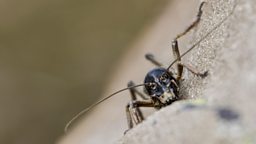
New Zealand was isolated for more than 80 million years, and ended up with a strange crew of castaway creatures. It never originally had mammals like rodents or stoats, so evolution was able to find its own strange path and some of the unlikeliest animals developed the unexpected skills and habits.
Perhaps the most extreme adaptation of all New Zealand鈥檚 bizarre invertebrate fauna is that of the mountain stone weta.
In the extremely damp wet landscapes of Southern New Zealand, a famously sluggish group of slimy creatures became carnivores: snails! Powelliphanta snails can grow to the size of a man’s fist and have eye-bogglingly revolting table manners.
Sadly many species are very rare today so the only way to film their predatory predilections was to work closely with Department of Conservation and animals from one of their captive breeding programmes. The species we filmed liked nothing better than to suck up earthworms like living spaghetti!
Perhaps the most extreme adaptation of all New Zealand’s bizarre invertebrate fauna is that of the mountain stone weta. A remarkable insect with the ability to survive being seemingly frozen solid. It can cope with repeated cycles of freeze and thaw and freeze and thaw and come out alive and kicking. It is the world’s largest freeze tolerant insect and can withstand 80 percent of its body tissues freezing.

These are all truly remarkable feats, if you consider the mountain stone weta’s origin. Wetas are an ancient family of cricket-like insects whose family tree dates back to the time when New Zealand was joined up with all the other southern continents as a part of the vast ancient land of Gondwana around 200 million years ago. Back then Gondwana was a largely temperate wet forested continent ruled by dinosaurs.
...they have lived through landscape change on an enormous scale.
Wetas have been isolated on New Zealand for so long, they have lived through landscape change on an enormous scale. The Southern Alps are a positively youthful mountain chain that put on a massive growth spurt around five million years ago, (a mere blink of evolutionary and geological time.) Weta species which once lived in lowland prehistoric woods were raised up into the alpine zone by mountains that literally grew up under their feet. The freeze tolerant survival skill of the mountain stone weta today attests to their adaptability. Their kind have seen ice ages come and go, and now have to deal with temperatures which freeze and thaw on a daily basis.
Working closely with the Otago university department of Zoology, in a carefully controlled filming chamber, we could capture the extraordinary freezing and de-frosting capability of the weta which would have been impossible to accomplish in their natural habitat.

